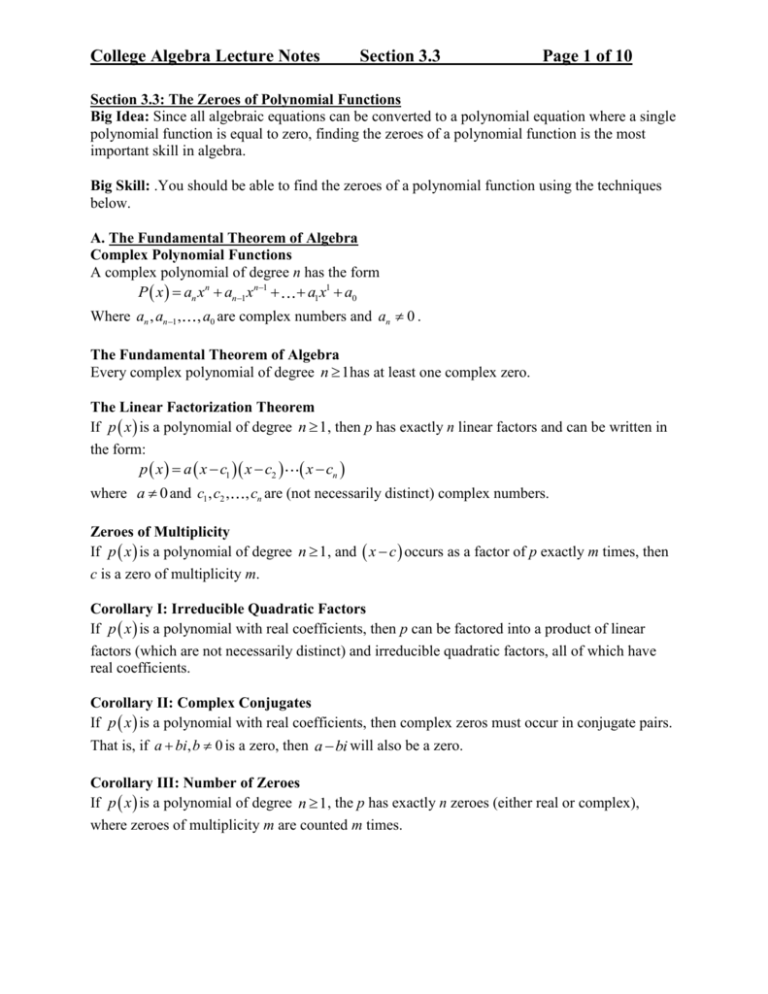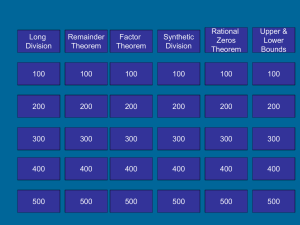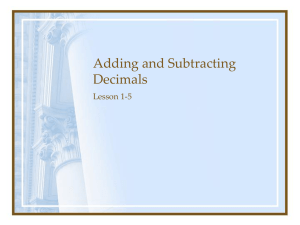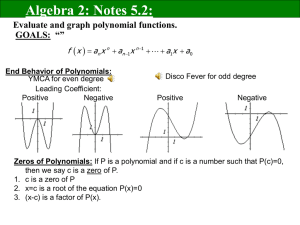College Algebra Lecture Notes, Section 3.3
advertisement

College Algebra Lecture Notes Section 3.3 Page 1 of 10 Section 3.3: The Zeroes of Polynomial Functions Big Idea: Since all algebraic equations can be converted to a polynomial equation where a single polynomial function is equal to zero, finding the zeroes of a polynomial function is the most important skill in algebra. Big Skill: .You should be able to find the zeroes of a polynomial function using the techniques below. A. The Fundamental Theorem of Algebra Complex Polynomial Functions A complex polynomial of degree n has the form P x an xn an1 xn1 a1 x1 a0 Where an , an1 , , a0 are complex numbers and an 0 . The Fundamental Theorem of Algebra Every complex polynomial of degree n 1has at least one complex zero. The Linear Factorization Theorem If p x is a polynomial of degree n 1, then p has exactly n linear factors and can be written in the form: p x a x c1 x c2 x cn where a 0 and c1 , c2 , , cn are (not necessarily distinct) complex numbers. Zeroes of Multiplicity If p x is a polynomial of degree n 1, and x c occurs as a factor of p exactly m times, then c is a zero of multiplicity m. Corollary I: Irreducible Quadratic Factors If p x is a polynomial with real coefficients, then p can be factored into a product of linear factors (which are not necessarily distinct) and irreducible quadratic factors, all of which have real coefficients. Corollary II: Complex Conjugates If p x is a polynomial with real coefficients, then complex zeros must occur in conjugate pairs. That is, if a bi, b 0 is a zero, then a bi will also be a zero. Corollary III: Number of Zeroes If p x is a polynomial of degree n 1, the p has exactly n zeroes (either real or complex), where zeroes of multiplicity m are counted m times. College Algebra Lecture Notes Section 3.3 Practice: 1. Find the linear factors and all zeroes of p x x4 21x2 100 . 2. Find the linear factors and all zeroes of p x 2x3 4x2 2x . Page 2 of 10 College Algebra Lecture Notes Section 3.3 3. Find the linear factors and all zeroes of p x x3 4 x2 16 x 64 . 4. Find the linear factors and all zeroes of p x x3 x . Page 3 of 10 College Algebra Lecture Notes Section 3.3 Page 4 of 10 B. Real Polynomials and the Intermediate Value Theorem Note that the theorems on the previous pages only state the fact that solutions do exist; they say nothing about how to find those solutions. In the following pages, we look at theorems that help us find actual values for the solutions. There are several different theorems for several different scenarios. The Intermediate Value Theorem allows us to verify that a solution exists somewhere within an interval of numbers, and can also be used to zoom in closer on a value. The Intermediate Value Theorem If P x is a polynomial with real coefficients, and P a and P b have opposite signs, then there is at least one value c between a and b such that P c 0 . Practice: 5. Use the intermediate value theorem to verify that P x x3 2x 0.5 has a zero in the interval x 1, 2 . 6. Use the intermediate value theorem to narrow down the interval in which that zero of P x x3 2x 0.5 occurs. College Algebra Lecture Notes Section 3.3 Page 5 of 10 C. The Rational Zeroes Theorem The Rational Zeroes Theorem If P x is a polynomial with integer coefficients, then any existing rational zeros of P x must be of the form of a rational number of the leading coefficient. p q , where p is a factor of the constant term and q is a factor Notice that if we have the special case of a polynomial with integer coefficients, then the rational zeroes theorem predicts some possible answers for us, and all we need to do is verify which of those predictions are true zeroes. Tests to Determine if 1 or -1 is a Zero of a Polynomial If P x is a polynomial with real coefficients, then If the sum of all coefficients is zero, then 1 is a root and (x – 1) is a factor. If after changing all the signs of all terms with odd degree the sum of all coefficients is zero, then -1 is a root and (x + 1) is a factor. Notice that this theorem gives us a shortcut for checking two of the always possible zeros of a polynomial with integer coefficients. Practice: 7. Find the zeroes of the polynomial function p x 2x 1 3x 2 5x 7 , then expand the polynomial, list all possible zeroes predicted by the rational zeroes theorem, and note that the actual zeroes are in that set. College Algebra Lecture Notes Section 3.3 Page 6 of 10 8. Find the factors and zeroes of the polynomial function p x x3 21x 20 using the rational zeroes theorem. 9. Find the factors and zeroes of the polynomial function p x 9 x3 7 x 2 using the rational zeroes theorem. College Algebra Lecture Notes Section 3.3 Page 7 of 10 D. Descartes’ Rule of Signs and Upper/Lower Bounds Descartes’ Rule of Signs If P x is a polynomial with real coefficients, and we want to solve P x 0 , The number of positive real zeroes is equal to the number of variations in the signs of the coefficients of P x , or an even number less. The number of negative real zeroes is equal to the number of variations in the signs of the coefficients of P x , or an even number less. Notice that this theorem can be used to make factoring more efficient, because if we first test for the number of positive and negative roots, then we know we can stop checking when we find that number of each kind of root. Upper and Lower Bounds Property If P x is a polynomial with real coefficients, then If P x is divided by x b , b 0 using synthetic division and all coefficients in the quotient row are either positive or zero, then b is an upper bound on the zeros of P x . If P x is divided by x a , a 0 using synthetic division and all coefficients in the quotient row alternate in sign, then a is a lower bound on the zeros of P x . Zero coefficients in the quotient row can be either positive or negative as needed. Notice that this theorem also makes factoring more efficient, because if we start with small factors and work our way out until the properties apply, then we know we can stop. Practice: 10. Construct a polynomial with three positive rational roots and notice how the signs of the coefficients alternate. Also list all possible rational roots, and notice how the upper and lower bounds properties apply. College Algebra Lecture Notes Section 3.3 Page 8 of 10 11. Construct a polynomial with one positive root and a pair of complex conjugate roots. Notice how the signs of the coefficients still alternate, but that there is only 3 – 2 = 1 positive root. 12. Construct a polynomial with three negative roots and notice how the signs of the coefficients of P(-x) alternate. Also list all possible rational roots, and notice how the upper and lower bounds properties apply. College Algebra Lecture Notes Section 3.3 Page 9 of 10 13. Construct a polynomial with one negative root and a pair of complex conjugate roots. Notice how the signs of the coefficients of P(-x) still alternate, but that there is only 3 – 2 = 1 negative root. 14. Find the factors and zeros of g x 3x4 4 x3 21x2 10 x 24 . College Algebra Lecture Notes E. Applications of Polynomial Functions Practice: 15. . Section 3.3 Page 10 of 10








